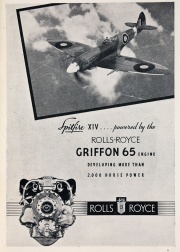Rolls-Royce Engines: Griffon




Note: This is a sub-section of Rolls-Royce
The Rolls-Royce Griffon was a 2,240 in³ (36.75 litre), 60-degree V-12 aero-engine, developed from the earlier Rolls-Royce R racing engine used in the Schneider Trophy races.
The Griffon was designed prior to WWII and was originally intended as a low-altitude engine for naval aircraft such as the Fairey Firefly but a formal suggestion to fit a Griffon in a Spitfire was made by Joe Smith, who had taken over as Chief Designer at Supermarine's after Mitchell's death, in June 1937. However, work by Rolls-Royce on the engine had been halted temporarily to concentrate on the smaller 1,649 in³ (27 litre) Merlin which had already surpassed the output achieved with the early Griffon.
When the development work on the Griffon was resumed, it was decided to fit the engine to a Spitfire. The first example of this was a single Spitfire Mk.IV, DP845, a modified clipped-wing Spitfire Mk.III which flew with a Griffon RG 2SM on 27 November 1941.
Pilot conversion from Merlin-engined to Griffon-engined Spitfires was not without teething troubles, the most common problem being the ingrained habit of applying a starboard trim to the aircraft's rudder to offset the tremendous torque produced at takeoff power. As the Griffon's crankshaft rotated in the opposite direction to that of the Merlin (a legacy of its intended use for naval aircraft, where it is desirable for aircraft to swing to port, away from the carrier's superstructure), a starboard bias increased, instead of compensating for, the undesirable effects of torque. This problem was never fully overcome in land-based Spitfires, although the Seafire FR.47 and the occasional Spitfire 21 or 24 were fitted with a contra-rotating propeller as standard, thus negating air-screw torque.
Rolls-Royce applied the advances in supercharging used on the Merlin to the Griffon, and later Griffon versions featured two-stage supercharging and finally a two-stage, three-speed supercharger.
The two-stage, three-speed Griffon 101 was fitted to the two Supermarine Spiteful XVIs (re-engined production Mk.XIVs) with one of these aircraft, RB518, achieving a maximum speed of 494 mph (795 km/h) with full military equipment.
The Griffon was also used in the Avro Shackleton maritime patrol aircraft, also with contra-rotating propellers.
Note: The Griffon was a "left-hand tractor" engine ie; the propeller rotated to the left when viewed from behind.
Variants
- Griffon II - 1,730 hp (1,290 kW) at 750 ft (230 m) and 1,490 hp (1,110 kW) at 14,000 ft (4,270 m); used on Firefly Mk.I fighter
- Griffon VI - increased maximum boost pressure, 1,850 hp (1,380 kW) at 2,000 ft (610 m); used on Seafire Mk.XV and Mk.XVII
- Griffon 57 - 1,960 hp (1,460 kW); used on Avro Shackleton
- Griffon 61 - introduced a two-speed two-stage supercharger with after-cooler similar to that on Merlin 61; 2,035 hp (1,520 kW) at 7,000 ft (2,135 m) and 1,820 hp (1,360 kW) at 21,000 ft (6,400 m); used on Spitfire Mk.21
- Griffon 65 - similar to Griffon 61 with different propeller reduction gear; used on Spitfire Mk.XIV
- Griffon 72 - increased maximum boost pressure to take advantage of 150-grade fuel; 2,245 hp (1,675 kW) at 9,250 feet (2,820 m)
- Griffon 74 - fuel-injected version of Griffon 72; used on Firefly Mk.IV
- Griffon 83 - modified to drive contra-rotating propellers; 2,340 hp (1,745 kW) at 750 ft (230 m) and 2,100 hp (1,565 kW) at 12,250 ft (3,740 m)
- Griffon 85 - 2,375 hp (1,770 kW); used on Spiteful Mk.XIV
- Griffon 89 - 2,350 hp (1,755 kW); used on Spiteful Mk.XV
- Griffon 101 - 2,420 hp (1,805 kW); used on Spiteful Mk.XVI
General characteristics
- Type: 12-cylinder supercharged liquid-cooled 60° Vee aircraft piston engine
- Bore: 6 in (152.4 mm)
- Stroke: 6.6 in (167.6 mm)
- Displacement: 2,239 in³ (36.7 L)
- Dry weight: 1,980 lb (900 kg)
Components
- Valve-train: Two intake and two exhaust valves per cylinder with sodium-cooled exhaust valve stems, actuated via an overhead camshaft.
- Supercharger: Two-speed two-stage centrifugal type supercharger, boost pressure automatically linked to the throttle, water-air after-cooler installed between the second stage and the engine
- Fuel system: Triple-choke updraft carburettor with automatic mixture control
- Oil system: Dry sump with one pressure pump and two scavenge pumps
- Cooling system: 70% water and 30% ethylene glycol coolant mixture, pressurized
Power output
- 2,035 hp (1,520 kW) at 7,000 ft (2,135 m)
- 1,820 hp (1,360 kW) at 21,000 ft (6,400 m)
- Specific power: 0.91 hp/in³ (41.4 kW/L)
- Power-to-weight ratio: 1.03 hp/lb (1.69 kW/kg)
See Also
Sources of Information
- [1] Wikipedia

